I arrived for my 6-day French-immersion home-stay on Sunday, April 28 after a four-hour train ride from Paris, with a train change in the city of Limoges. My hostess, Monique, picked me up at the station in the small town of Thiviers. It’s located in the Périgord Vert, the northernmost part of the Dordogne. Guidebooks say the Dordogne is in southwest France; southwest-ish is more like it I think, as Nevada might be described as in the southwest of the US. Périgord is the ancient provinical name for the region, and is preferred by people who live there. It’s divided into the Périgord Vert, Blanc, Noir and Pourpre (green, white, black and purple).
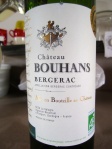 The Noir, anchored by the picture-perfect little town of Sarlat, is south of here, and has more tourism. In 2011, I spent a week near Sarlat with Santa Rosa chef and restauranteur Michael Hirschberg’s group at the lovely B&B run by Santa Rosans Caitlin and Albert Woodbury. The Périgord Noir is especially known for truffles and the prehistoric Lascaux cave paintings. The Purple contains the wine region of Bergerac. Monique served excellent red Bergerac wine with meals.
The Noir, anchored by the picture-perfect little town of Sarlat, is south of here, and has more tourism. In 2011, I spent a week near Sarlat with Santa Rosa chef and restauranteur Michael Hirschberg’s group at the lovely B&B run by Santa Rosans Caitlin and Albert Woodbury. The Périgord Noir is especially known for truffles and the prehistoric Lascaux cave paintings. The Purple contains the wine region of Bergerac. Monique served excellent red Bergerac wine with meals.
After a drive of about 20 kilometers, which took us through a countryside with gently rolling green hills and a couple of small villages, we reached Monique’s home in a cluster of old stone buildings at a high point called Le Pic (the peak, though it was by no means what any of us would consider a peak). There are only four full-time-inhabited houses here, plus an English couple’s vacation home, and about six houses and several barns in varying states of disrepair. The French speak of La France Profond, the country roots from whence came most French families’ ancestors, and it is revered in a nostalgic sort of way. We are in La France Profonde.
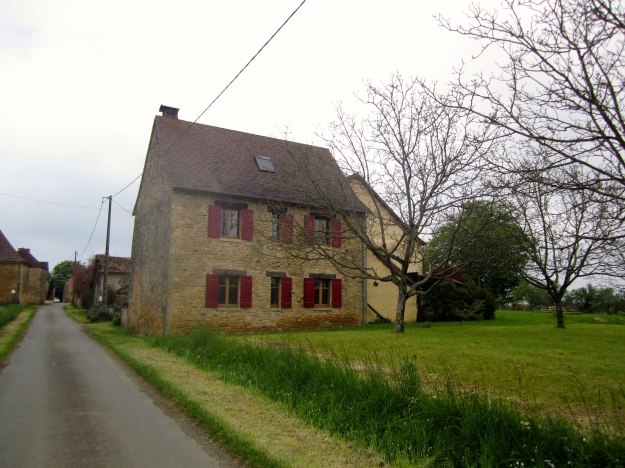 First view of Monique’s home with its cheerful red shutters, just past the neighbor’s walnut orchard. Downstairs windows, left to right: Living-Dining area; open kitchen; Bathroom with large walk-in shower. Upstairs windows: Great Room made cozy by a couch in front of a wood stove. This level also includes a large airy guest bedroom on the right, and a half-bath. Monique’s bedroom is in the attic. Its windows on the far end of the house face the back yard.
First view of Monique’s home with its cheerful red shutters, just past the neighbor’s walnut orchard. Downstairs windows, left to right: Living-Dining area; open kitchen; Bathroom with large walk-in shower. Upstairs windows: Great Room made cozy by a couch in front of a wood stove. This level also includes a large airy guest bedroom on the right, and a half-bath. Monique’s bedroom is in the attic. Its windows on the far end of the house face the back yard.
I could kick myself for neglecting to take pictures of the inside of the house. It is comfortable and inviting, with an uncluttered almost Zen feel. Furnished with almost equal portions of family antiques and modern, it is at once homey and charming. We spent six evenings and five-plus days taking long walks in the area, and traveling to see sights further afield, speaking only in French. It was a challenge that left me tired every night, but it went well. We understood each other, and she gently corrected my numerous errors.
 Here’s a not-very-good photo of Monique with her sweet dog, Flocky. They are contemplating cooking in the kitchen of an ancient château we visited.
Here’s a not-very-good photo of Monique with her sweet dog, Flocky. They are contemplating cooking in the kitchen of an ancient château we visited.
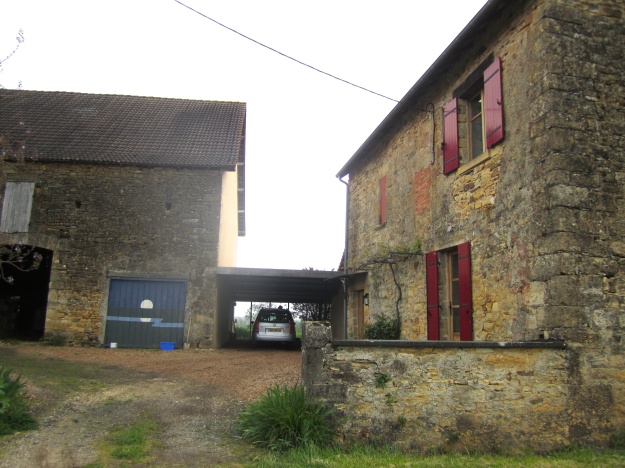 This is a typical layout for a country or small village home in a farming area: stone house facing a sort of courtyard with a stone barn. This courtyard and the carport area are covered in crushed walnut shells. Beyond the carport is about half an acre of land, with lawn, fruit trees, flowers and a vegetable garden.
This is a typical layout for a country or small village home in a farming area: stone house facing a sort of courtyard with a stone barn. This courtyard and the carport area are covered in crushed walnut shells. Beyond the carport is about half an acre of land, with lawn, fruit trees, flowers and a vegetable garden.
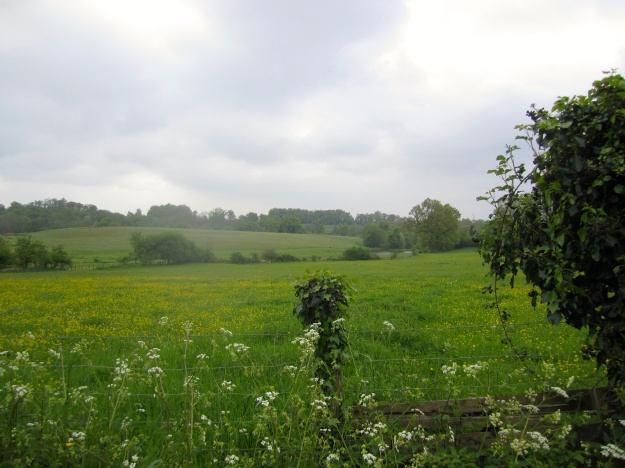 Here’s the peaceful bucolic view across the street. The neighbors to the left of this scene have a herd of sheep which they breed, and sell the lambs in the springtime. I didn’t realize that “spring lambs” are born in winter, but of course they must be, to be ready for the table by Easter.
Here’s the peaceful bucolic view across the street. The neighbors to the left of this scene have a herd of sheep which they breed, and sell the lambs in the springtime. I didn’t realize that “spring lambs” are born in winter, but of course they must be, to be ready for the table by Easter.
This is the rest of Le Pic. No traffic here to speak of, just a very occasional passing car or small truck. About half of the structures are in serious disrepair. Some are worse than others, with cracks and what appears to be serious structural damage.
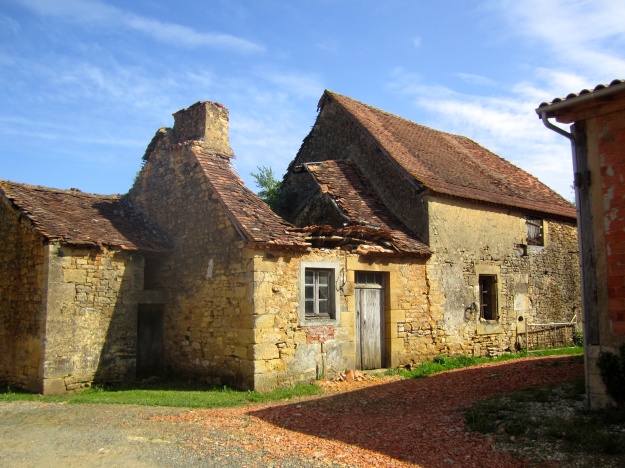 I have heard that if a house has a collapsed roof, the French government considers it uninhabitable, and the taxes are much lower. It is common for families who live in cities to have inherited homes, some in ruins, in villages where their families originated.
I have heard that if a house has a collapsed roof, the French government considers it uninhabitable, and the taxes are much lower. It is common for families who live in cities to have inherited homes, some in ruins, in villages where their families originated.
Above is the house voted “Least Habitable”. Still, it looks pretty and full of character in the sunshine (of which I saw precious little), doesn’t it?
Below is the site of a serendipitous experience I had. It is the perfectly kept home and farm of Monique’s friends, a Le Pic couple in their 80s. I strolled down the road, taking pictures, and was accosted by a barking dog. Madame came out to investigate, and ended up giving me a tour of her place. She was very cordial, and we chatted for a good 15 minutes.
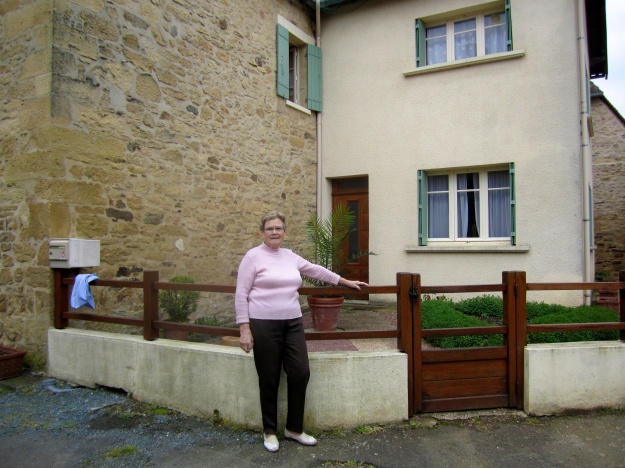 Madame graciously agreed to pose for a photo, after taking off her blue housewife-smock. I thought she looked exceptionally well-dressed for a country elder who was not expecting guests. The stone part of the house is hundreds of years old. The “new” stucco part was added only about 45 years ago. Madame, who was raised on a small farm not far from here, moved to her husband’s family home and farm when they married in 1955. They have one child, a son who is in the grocery and beer and wine distribution business in the nearby town of Excideuil. He comes out on weekends to help his father, but likes his own work and is not interested in taking over the farm.
Madame graciously agreed to pose for a photo, after taking off her blue housewife-smock. I thought she looked exceptionally well-dressed for a country elder who was not expecting guests. The stone part of the house is hundreds of years old. The “new” stucco part was added only about 45 years ago. Madame, who was raised on a small farm not far from here, moved to her husband’s family home and farm when they married in 1955. They have one child, a son who is in the grocery and beer and wine distribution business in the nearby town of Excideuil. He comes out on weekends to help his father, but likes his own work and is not interested in taking over the farm.
This is the back of the house, facing an exceptionally large courtyard, which is one of the prettiest I have ever seen. It is paved in gravel, and accented by olive trees in pots and half-barrels. There were wonderful smells of simmering soup wafting from the kitchen, on the right.
.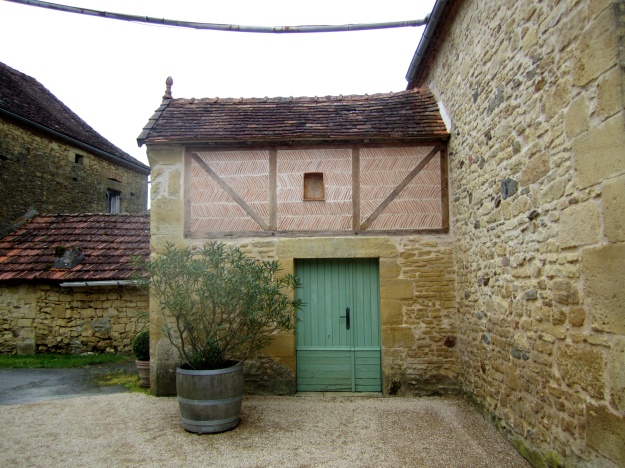 Everything is in tip-top condition. Behind the green door is a storeroom which has a freezer.
Everything is in tip-top condition. Behind the green door is a storeroom which has a freezer.
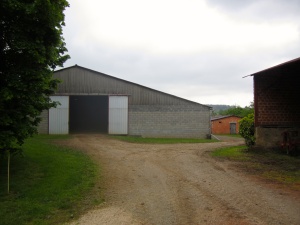 There is a newer barn where up until a year or two ago, they kept about 20 cows.
There is a newer barn where up until a year or two ago, they kept about 20 cows.
Perhaps they were dairy cows, though all the cattle I saw grazing in fields in the area were being raised for beef. The French are major meat-eaters.
Beyond is a field where they raised hay as fodder for the animals.
The large, high-roofed shed serves to store farm equipment. As you can see, there isn’t much left. It’s sad to see a farm without a tractor, every farmer’s pride. I can only imagine that in earlier days, this lofty storage area was full of the tools and implements and equipment of a bustling operation.
Laundry here dries the old-fashioned way, on a clothesline. Can you summon up that fresh smell from your memory-banks? I can.
 There is lawn now where the potager (kitchen vegetable and herb garden) used to be. As they age, the couple finds that they can no longer keep up with the hard work of the life they always knew. With no family to carry on, it looks as if the chain of generations of farmers on this land will end with Madame and Monsieur.
There is lawn now where the potager (kitchen vegetable and herb garden) used to be. As they age, the couple finds that they can no longer keep up with the hard work of the life they always knew. With no family to carry on, it looks as if the chain of generations of farmers on this land will end with Madame and Monsieur.
So dies a little hamlet, and a way of life.
À la prochaine,
Iz
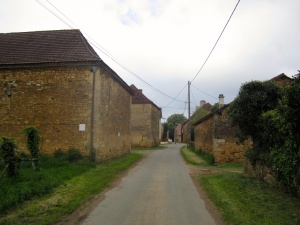

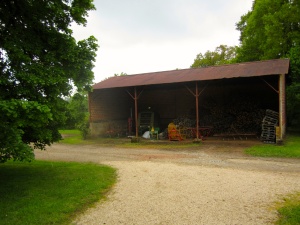

Excellent start on a blog, Iz. Looks very nice, indeed. Keep up the good work.
Bob
This is terrific, Iz. You write so well and what wonderful experiences you have had!
–Jen
When are you going to start leading tours to France. My brother and I want to go
If the automobile is in operating problem
and if it seems to be good, you must area an advertisement
for it. Take cover from the door breaching action and ambush the 4 Combine soldiers coming inside.
Look for the entrance right next to the neon ‘Open’ sign.